Gottstein G., Shvindlerman L.S. Grain Boundary Migration in Metals: Thermodynamics, Kinetics, Applications
Подождите немного. Документ загружается.


264 3 Grain Boundary Motion
XI — Aleshin AN, Aristov VJ, Bokstein BS, Shvindlerman LS. Phys.
Stat. Sol. (a), 45:359, 1978.
XII — Beyeler M, Adda Y. J. P hys. (Paris), 345, 1978.
XIII — Makin SM, Rowe AH, Claire AD. P roc. P hys. Soc. Lond.,
70:545, 1957.
XIV — Gupta D. J. Appl. P hys., 44:4455, 1973.
XV — Wadja ES, Shirn GA, Huntington HB. Acta Metall., 3:39, 1955.
XVI — G¨unther F, Haessner A, Oppermann L. Isotopenpraxis, 5:461,
1969.
XVII — Buescher BJ, Gilder HM, Shea N. Phys. Rev., B7:2261, 1973.
XVIII — Okkerse B. Acta Metall., 2:551, 1954.
XIX — Nachtrieb NH, Resing HA, Rice SA. J. Chem. P hys.,
31:135, 1959.
XX — Hudson JB, Hoffman RE. Trans. Met. Soc. AIME,
221:71, 1961.
XXI — Lange W, Haessner A, Berthold I. P hys. Stat. Sol., 1:50, 1961.
XXII — Curtin HR, Decker DL, Vanfleet HB. Phys. Rev., A139:1551,
1965.
XXIII — Smithells CJ. Metals Reference Book, 5th ed, Butterworths,
London, 1976.
XXIV – Star, JP, Upthegrove WR. Trans. ASM, 59:479, 1966.
XXV — Hudson JB. in Aeronautical Research Laboratory T echnical
Report, Wright Air Development Center, Dayton,
OH, cited from Ref.XXIV, Report 60-321, 1966.
Moreover, Eq. (3.174) shows that high values of pressure are necessary to
obtain an impact on grain boundary motion by pressure comparable to the
measured temperature influence. To compensate for the effect on grain bound-
ary mobility by a temperature change of the order of ∼250 K the pressure
should be changed by the order of ∼1 GPa. This demonstrates the serious
experimental problems which have to be overcome to properly measure the
pressure dependence of grain boundary mobility.
Grain boundary migration is the result of a net flux of lattice sites across the
grain boundary. This means that the transfer of an atom across the boundary
causes a new lattice site to be produced on the grain boundary face of the
growing crystal, while a lattice site at the grain boundary face of the shrinking
crystal is removed. If the process of grain boundary migration occurs by both
the hopping of single atoms across the boundary for the diffusion migration
and activation volume, both close to an atomic volume is to be expected.
Owing to the substantial experimental difficulties, there are only few sources
in the literature that address this item. Hahn and Gleiter [305] studied grain
growth in pure Cd (99.9999%) under high pressure (up to 28 kbar (2.86 GPa))
and at annealing temperatures 180-260
◦
C. The activation volume was not
calculated by Hahn and Gleiter, but their data permit us to derive it [304].
In Fig. 3.86 the rate of grain growth in Cd is given as a function of pres-
sure calculated in [124] from the data of [304]. It yields an activation volume
for grain growth, which can be associated with grain boundary migration:
© 2010 by Taylor and Francis Group, LLC
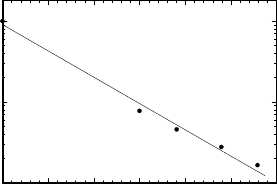
3.5 Experimental Results 265
0 5 10 15 20 25 30
10
100
1000
10
100
1000
0 5 10 15 20 25 30
0 5 10 15 20 25 30
10
1
10
2
10
3
ln[(<D>
2
-<D
0
>
2
)/t]
p [10
2
MPa]
0 5 10 15 20 25 30
10
100
1000
10
100
1000
0 5 10 15 20 25 30
0 5 10 15 20 25 30
10
1
10
2
10
3
ln[(<D>
2
-<D
0
>
2
)/t]
p [10
2
MPa]
FIGURE 3.86
Pressure dependence of the mobility (∼ D
2
/t) during grain growth [304, 305].
V
∗
=6.39 cm
3
/mol, or V
∗
=0.49 · Ω
a
(Ω
a
— atomic volume). Since the
ratio V
∗
SD
/Ω
a
for bulk self-diffusion in Cd ranges from 0.53 to 0.59, there is
reasonable agreement between V
∗
/Ω
a
and V
∗
SD
/Ω
a
.
Lojkowski [306] studied grain growth in Al (99.99%) under a pressure up to
25 kbar (2.5 GPa) at 400
◦
C. The activation volume ranged from 0.65–0.8 Ω
a
and depended on the thermomechanical history, i.e. on crystallographic tex-
ture of the polycrystals. The values of the activation volume for self-diffusion
in Al given in the literature are contradictory and range from 0.52–1.35 Ω
a
(Table 3.7). The latter reference seems to provide more accurate data. In any
event, V
∗
≤ V
∗
SD
.
As stressed many times, experiments on polycrystals provide only an aver-
age picture of the phenomenon. Also, as the majority of grain boundaries in
polycrystals have the character of random boundaries, the activation volume
of grain growth most likely reflects the activation volume of migration of ran-
dom grain boundaries.
Special and non-special 001 tilt grain boundaries were studied in tin [302,
303, 307]. Grain boundary migration was measured at atmospheric pressure
and at high hydrostatic pressure up to 16 kbar. The orientation dependencies
of activation enthalpy and activation volume of migration are given in Fig.
3.87. The activation enthalpy for the migration of special grain boundaries
is 1.5–2 times larger than the energy of activation for bulk self-diffusion and
almost by an order of magnitude larger than for grain boundary self-diffusion,
whereas the activation volume for special grain boundaries amounts to 0.6–
0.96 V
∗
SD
. However, for non-special grain boundaries the activation volumes
exceed V
∗
SD
by a factor of 2–2.5. This is a first indication that the activation
volume of grain boundary migration can substantially exceed the diffusion
activation volume.
The results of a comprehensive study of the temperature and pressure de-
© 2010 by Taylor and Francis Group, LLC

266 3 Grain Boundary Motion
ϕ,
Σ Σ Σ
H
SD
H
GBSD
V*
SD
0
5
10
15
20
20 25 30 35 40 45
Σ=13 Σ=17 Σ=5
0
V* [cm
3
/mol]
ϕ [deg]
H
m
[eV]
1.7
3.4
0.85
2.55
ϕ,
Σ Σ Σ
H
SD
H
GBSD
V*
SD
0
5
10
15
20
20 25 30 35 40 45
Σ=13 Σ=17 Σ=5
0
V* [cm
3
/mol]
ϕ [deg]
H
m
[eV]
1.7
3.4
0.85
2.55
FIGURE 3.87
Activation enthalpy (◦) and activation volume (•)of001 tilt grain boundary
migration in tin.
pendencies of 100, 110,and111 tilt grain boundaries in bicrystals of pure
Al are given in Figs. 3.88 and 3.89 [304]. The activation volumes for 100 and
111 tilt boundaries are identical and independent of the angle of rotation,
quite in contrast to the behavior of the activation enthalpy. The absolute
value of about 12 cm
3
/mol corresponds to slightly more than one atomic vol-
ume in aluminum and is, therefore, close to the activation volume for bulk
self-diffusion. As mentioned above, the activation volume is the difference be-
tween the volume of the activated and the ground state. For self-diffusion this
is essentially the volume of a vacancy, which has to be provided for the ele-
mentary diffusive step. The finding of an activation volume for grain boundary
migration close to that of bulk self-diffusion suggests that a diffusion process
controls the boundary migration rate. On the other hand, the intrinsic grain
boundary mobility, e.g. in the absence of impurities, is not likely to yield ac-
tivation volumes very different from a single atomic volume, since a diffusive
jump across the boundary by detaching an atom from the shrinking grain
and attaching it to the growing one requires the generation of a lattice site
at the internal surface of the growing crystal. If large structural vacancies do
not exist in the boundary, then the creation of a lattice site in the boundary
requires a volume change close to an atomic volume. In fact, computations of
grain boundary structure at 0 K do not predict large excess volumes in grain
boundaries, at least not in special boundaries. The results for 100 and 111
tilt boundaries are, therefore, quite in line with our current understanding of
grain boundary motion by the hopping of single atoms across the boundary.
By contrast the activation volume for 110 tilt boundaries increases with
increasing departure from the exact low Σ coincidence misorientation, as is
also the case for the activation energy (Fig. 3.88). For a 30
◦
110 bound-
© 2010 by Taylor and Francis Group, LLC

3.5 Experimental Results 267
1.0 1.5 2.0 2.5 3.0 3.5
E [eV]
5
10
15
20
25
30
35
40
V
*
[
c
m
3
/
m
o
l
]
5
10
15
20
25
30
35
40
1 1.5 2 2.5 3 3.5
<100>
<111>
<110>
40
35
30
25
20
15
10
5
V* [cm
3
/mol]
1.0 1.5 2.0 2.5 3.0 3.5
H
m
[eV]
<100>
<111>
<110>
1.0 1.5 2.0 2.5 3.0 3.5
E [eV]
5
10
15
20
25
30
35
40
V
*
[
c
m
3
/
m
o
l
]
5
10
15
20
25
30
35
40
1 1.5 2 2.5 3 3.5
<100>
<111>
<110>
40
35
30
25
20
15
10
5
V* [cm
3
/mol]
1.0 1.5 2.0 2.5 3.0 3.5
H
m
[eV]
<100>
<111>
<110>
FIGURE 3.88
Activation volume vs. activation enthalpy of tilt grain boundary migration in
Al (tilt axis indicated).
ary, which deviates by ∼ 8
◦
from the Σ9 boundary, the activation volume
amounts to 36 cm
3
/mol equivalent to more than three atomic volumes. Such
large activation volume cannot be justified in terms of individual atomic jump
mechanisms of grain boundary migration. Rather, such values are evidence
that more than a single atom is involved in the fundamental process of grain
boundary migration.
Migration mechanisms, based on groups of atoms, can consist either of
the concomitant migration of groups or a cooperative motion (chain transfer)
by coordinated serial motion of atoms. Group mechanisms of grain boundary
migration have been proposed by several authors in the past, but without
any proof of evidence. In his island model of grain boundary structure, Mott
proposed that little patches of perfect crystal structure will detach from one
crystal and attach at the other side of the boundary [162]. Such a model of
grain boundary migration, however, is not compatible with our current knowl-
edge of grain boundary structure. Grain boundaries are very narrow with lit-
tle excess volume and do not give room for floating crystal patches across the
boundary. In a computer simulation carried out by Shan and Bristowe [308],
as well as Sch¨onfelder, Wolf et al. [309], it was found that concurrent shuffling
of groups of atoms may take place during migration.
3.5.9 Effect of Grain Boundary Orientation
3.5.9.1 Anisotropy of Grain Boundary Motion
Thus far, we have considered the dependency of grain boundary mobility
on misorientation between the adjacent grains only. A grain boundary, how-
© 2010 by Taylor and Francis Group, LLC

268 3 Grain Boundary Motion
10
-1
10
2
10
5
10
8
10
11
A
0
[m
2
/s]
5
10
15
20
25
30
35
40
V
*
,
c
m
3
/
m
o
l
5
10
15
20
25
30
35
40
0.1 1 10 100 1000100001000001E+0061E+0071E+0081E+0091E+0101E+0111E+012
<100>
<111>
<110>
35
40
30
25
20
15
10
5
10
-1
10
2
10
5
10
8
10
11
A
0
[m
2
/s]
V* [cm
3
/mol]
<100>
<111>
<110>
10
-1
10
2
10
5
10
8
10
11
A
0
[m
2
/s]
5
10
15
20
25
30
35
40
V
*
,
c
m
3
/
m
o
l
5
10
15
20
25
30
35
40
0.1 1 10 100 1000100001000001E+0061E+0071E+0081E+0091E+0101E+0111E+012
<100>
<111>
<110>
35
40
30
25
20
15
10
5
10
-1
10
2
10
5
10
8
10
11
A
0
[m
2
/s]
V* [cm
3
/mol]
<100>
<111>
<110>
FIGURE 3.89
Activation volume vs. preexponential reduced mobility factor of tilt grain
boundary migration in Al (tilt axis indicated).
ever, is also defined by its spatial orientation (inclination), which is commonly
changing along the boundary between adjacent grains. It is usually tacitly as-
sumed that the (spatial) orientation of a boundary does not seriously affect
grain boundary mobility. This is not always true, however, as evident from
recrystallized microstructures of fcc materials with low stacking fault energy,
which exhibit a high density of slim annealing twins (Fig. 3.90). Despite a
common orientation relationship the mobility of the long straight coherent
twin boundaries is obviously much lower than that of the other, incoherent
twin boundaries. Not only twin boundaries exhibit an anisotropy of mobility
for a given misorientation relationship. This is most easily demonstrated from
bicrystal experiments where a boundary is allowed to freely expand in a vol-
ume.
Such a case can be achieved by utilizing growth selection in a steep tem-
perature gradient of a slightly deformed single crystal with the shape of a
shovel [310] (Fig. 3.91). Growth selection is set off at the top of the handle
and is terminated when the remaining single grain boundary has reached the
bottom of the handle. Subsequently, the entire shovel is subjected to an an-
nealing treatment, during which the boundary freely expands into the blade
of the shovel, driven by the stored energy of cold work in the slightly rolled
single crystal shovel.
Although during growth selection certain orientations are strongly pre-
ferred over others in growth competition, other orientation relationships also
are occasionally observed to survive. From a large number of experiments it is
evident that grain boundaries with 100 and 110 rotation axis grow fairly
isotropically, i.e. the final shape of the growing grain is a semicircle (Fig. 3.92).
For a 111 rotation axis a very anisotropic grain boundary mobility is ap-
parent, and the growing grain assumes the shape of a rectangle (Fig. 3.93).
© 2010 by Taylor and Francis Group, LLC
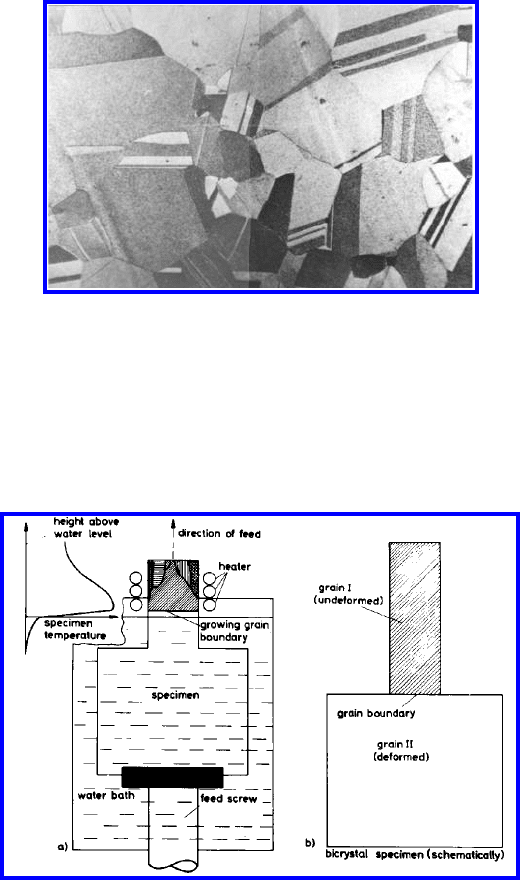
3.5 Experimental Results 269
FIGURE 3.90
Microstructure of recrystallized brass. Note anisotropic grain shape of anneal-
ing twins.
FIGURE 3.91
(a) Principle of the production of a bicrystal from a deformed single crystal
in a gradient furnace; (b) idealized form of the used bicrystal.
© 2010 by Taylor and Francis Group, LLC
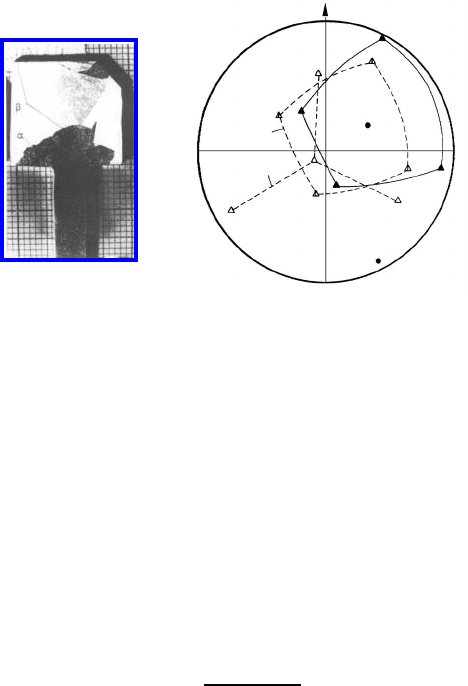
270 3 Grain Boundary Motion
RD
TD
[001]
[010]
Grain α
Grain β
(a) (b)
RD
TD
[001]
[010]
Grain α
Grain β
(a) (b)
FIGURE 3.92
Isotropic grain growth of grain boundaries with 100 rotation axis. (a) Grain
β was nucleated spontaneously from the surface (b).
The long straight facet of the grown grain, i.e. the slowly moving boundary,
is determined by the crystallography of the growing grain rather than by the
shovel geometry. If the shovel is machined out differently from the rolled sin-
gle crystal, the spatial orientation of the slowly growing facet follows exactly
the change of the crystallographic directions in the deformed single crystal
(Fig. 3.94). The long facet is always perpendicular to the 111 rotation axis,
i.e. this slowly moving facet is a twist boundary. The degree of anisotropy Λ,
defined by
Λ=
elongation
broadening
(3.175)
of the grain, is not a function of angle of rotation, but rather is strongly depen-
dent on the deviation of the actual rotation axis from an ideal 111 axis (Fig.
3.95). The more perfect the twist character of the boundary, the larger Λ, up
to a factor of 100 for the ideal 111 twist boundary, which is most perfectly
achieved for the coherent twin boundary. A deviation by 2 degrees reduces the
anisotropy already by a factor of 10. An ideal 111 twist boundary consists
of two perfectly flat {111} planes of the adjacent crystals, and it is easy to
imagine that it is difficult to remove or attach atoms to these planes, i.e. to
make the grain boundary move.
It was frequently observed that the growing grain assumed the shape
of a triangle rather than a rectangle (Fig. 3.96). One of the straight faces
was identified as a twist boundary, while the other triangular boundary was
faceted comprising piecewise twist boundary facets. For a single crystal ori-
entation symmetrical with regard to the growth direction in the handle of
the shovel, two symmetrically equivalent orientations frequently survived the
© 2010 by Taylor and Francis Group, LLC
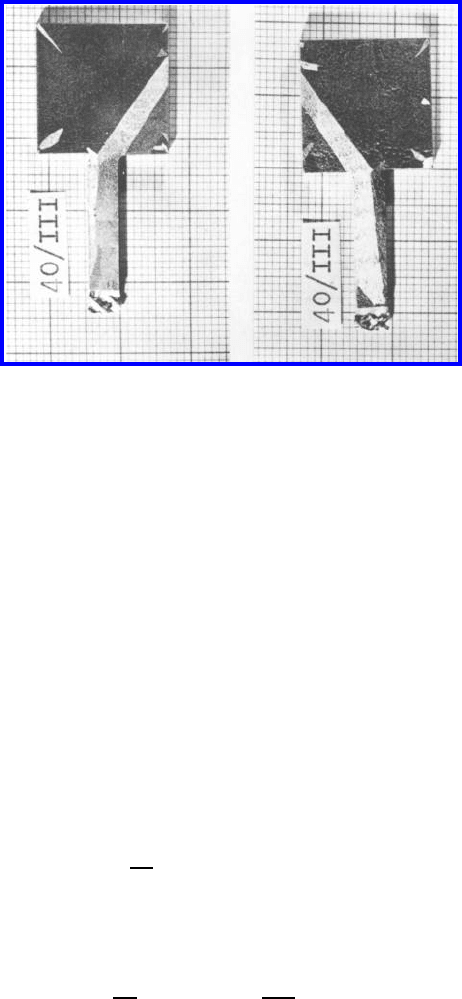
3.5 Experimental Results 271
FIGURE 3.93
Rectangular-shaped grain obtained by free planar growth in Al. Deformed
grain in Goss orientation (110)[001]. Orientation relationship between grains
approximately 46
◦
111.
growth competition, one of which became rectangular while the other one as-
sumed a triangular shape (Fig. 3.97). Although the reason for this behavior is
not yet clear, it may be related to the dependence of grain boundary mobility
on direction of motion, as will be shown in Sec. 3.5.9.2.
This anisotropy of grain boundary mobility manifests itself by an ellipticity
of grain morphology during free growth of a grain in a homogeneous environ-
ment. The first-order twin boundaries (60
◦
111) are the most prominent, but
not the only example. For a general mathematical description of grain shape
evolution, the displacement of a grain boundary element parallel to its normal
has to be considered (Fig. 3.16). Including forces by grain boundary surface
tension γ and a volume driving force P for its motion, we arrive at the shape
evolution equation y(x, t) (see also Sec. 3.3.6)
∂y
∂t
= V − Pm
b
+ m
b
γκ (3.176)
where V is the speed of a (dragging) groove, and κ is curvature. If the bound-
ary slope is small ((∂y/(∂x) 1) then a linear equation is obtained
∂y
∂t
= V + m
b
γ
∂
2
y
∂x
2
− P
(3.177)
The solution of this partial differential equation depends on the magnitude
of the driving forces and the orientation dependent mobility of the boundary.
© 2010 by Taylor and Francis Group, LLC
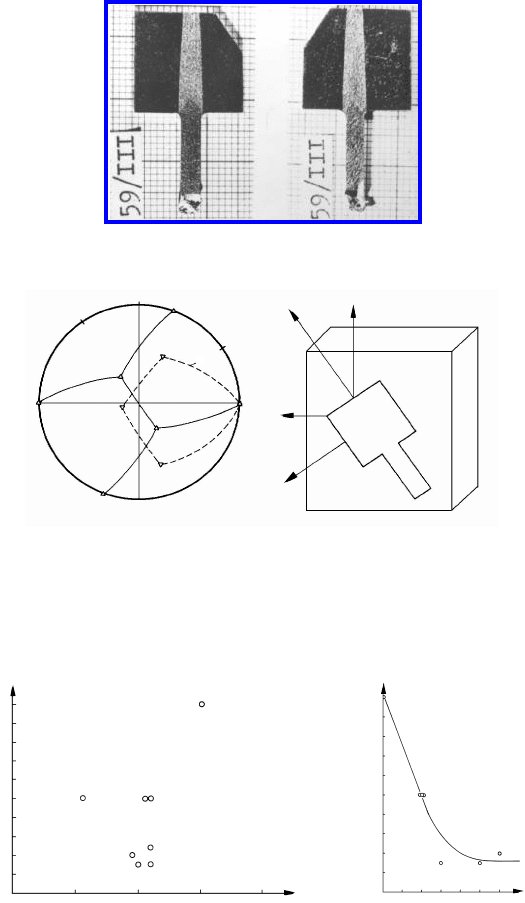
272 3 Grain Boundary Motion
R
D
L D
A
T
D
C
D
L D
R D
T D
C D
Al - rolled 30% Matrix: (011) [100] grain d:32° [D]
d
(a)
(b)
R
D
L D
A
T
D
C
D
L D
R D
T D
C D
Al - rolled 30% Matrix: (011) [100] grain d:32° [D]
d
(a)
(b)
FIGURE 3.94
The same rolling sample as Fig. 3.93, (a) shovel cut in such a way that the
{111} plane is parallel to longitudinal direction (b).
Λ
Λ
ϕ
[deg]
ρ
111
20 40 60 80
50
100
2460
0
20
40
60
80
0
0
100
(a)
(b)
Λ
Λ
ϕ
[deg]
ρ
111
20 40 60 80
50
100
2460
0
20
40
60
80
0
0
100
(a)
(b)
FIGURE 3.95
Shape anisotropy A of grain grown with 111 rotation axis to consumed grain
in Al. (a) Dependence on rotation angle; (b) dependence on deviation of the
actual rotation axis from the ideal 111 axis.
© 2010 by Taylor and Francis Group, LLC

3.5 Experimental Results 273
RD
11°
T D
(a) (b)
RD
11°
T D
(a) (b)
FIGURE 3.96
Triangular-shaped grain (a); the orientation of the triangular-shaped grain
(b).
For an isotropically moving boundary the solution will be a sphere in three
dimensions or a circle in two dimensions. For the general case, i.e. more com-
plicated conditions with regard to mobility and surface tension, solutions are
yet to be derived.
3.5.9.2 Impact of Boundary Orientation on the Steady-State
Motion of Curved Grain Boundaries
The growth selection experiments have shown the high anisotropy of 111
grain boundaries in the course of grain growth [310].
The steady-state motion of a grain boundary under the action of its own
surface tension was analyzed in Sec. 3.4.3. Since the differently inclined bound-
ary elements may have different reduced mobilities, in general the velocity of
a curved boundary moving in steady state depends on its orientation [256].
The only exception are tilt grain boundaries in a crystal lattice with inversion
symmetry (100 tilt boundaries). Such effect was observed, for instance, for
half-loop migration of 11
¯
20 tilt boundaries in Zn [247].
In [311] an attempt was undertaken to consider this phenomenon for the
steady-state motion of 111 tilt and mixed tilt-twist grain boundaries in Al
bicrystals. The steady-state motion of a quarter-loop boundary in two con-
figurations was studied (Fig. 3.98). The boundary configuration sketched in
Fig. 3.98a can be represented by a series of differently inclined “pure tilt” ele-
ments whereas the boundary with the configuration of Fig. 3.98b is composed
of a series of mixed tilt-twist elements with changing twist component along
the boundary.
The motion of curved grain boundaries with rotation axis 111 and
misorientation angles between 34
◦
and 42
◦
in both configurations shown in
© 2010 by Taylor and Francis Group, LLC
